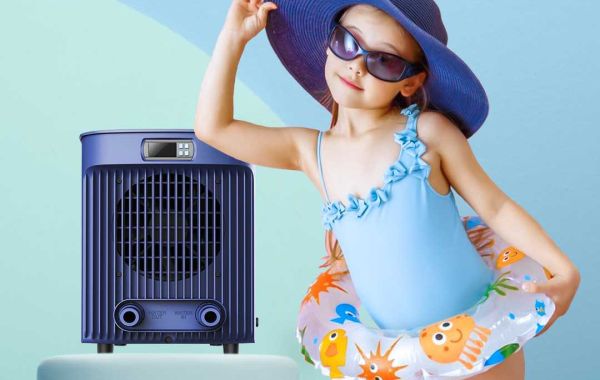When we choose a swimming pool heat pump, there are 3 aspects that must be considered:
1. Heat required for initial heating
Usually, we want the initial heating time to be less than 48 hours.
The heating capacity required by the shape of the swimming pool is different.
Generally, there are the following shapes:
1) rectangle or square 1,000 liters = 1 cubic meters (m3)
2) round 1,000 liters = 0.89 cubic meters (m3)
3) bean-shaped 1,000 liters =0.85 cubic meters (m3)
The general formula for calculating the amount of heat required to heat a swimming pool is:
Pool volume*target temperature difference*1.16 ( Generally, it takes around 1.16kWh to heat up 1 litre of water by 1°C)
Take an example of a rectangle or square pool, if we warm a 60m³ pool by 10 ° C with a running time of 40 hours.
Then we need a heat pump with an output of approx. 17.4 kW= (60*10*1.16)/40
2. Heat required for constant temperature maintenance:
To maintain the water temperature of the swimming pool, we usually need to consider the following factors
- Heat from water evaporation
- Heat loss from water surface conduction (with or without pool cover)
- Heat loss by conduction from the bottom and walls of the pool
- Heat lost in water exchange
- Heat loss from pipes and equipment
- Shape (dimensions)
- Pool material (Fiberglass pools are both the easiest type of pool to heat and the least expensive. In contrast to vinyl and concrete pools, which have little to no ability to retain warmth, fiberglass is an insulator so it holds heat in your pool.)
- Pool location
Indoor and outdoor pool case
The measurement process of influencing factors is professional and complicated. If possible, please ask your local professional installation team to accurately measure you.
Here is an abbreviated formula (including the aforementioned contributing factors) to help you quickly measure the type of heat pump you need:
for example,
If the pool is outside and the heat pump is only used in summer at 26°C, the required heat pump heating capacity is
10*4*0.79=31.6KW,
If the pool is indoors and the heat pump is only used in summer at 26°C, the heat pump heat required is
10*4*0.384=15.36KW,
Let’s make a brief summary.
When selecting a heat pump for the pool, we need to consider the heating capacity both enough for initial warm-up and temperature maintenance.
If the swimming pool is in the outdoors, although only 17.4 kW is required for initial heating
But maintain the temperature, the pool needs 31.6 kW.
So it is necessary to consider purchasing a pool heat pump with a capacity of more than 31.6 kW;
If the swimming pool is indoors, initial heating requires 17.4 kW, and maintaining the temperature requires 15.36 KW.
In this case, if you are willing to wait a little more heating time, you can consider a swimming pool heat pump with a capacity of 15.36 KW or more; Adjust the time you want and calculate the required heat pump model.
3. COP
Knowing how to choose the right model can not only avoid choosing too much heating capacity to increase the initial investment cost but also avoid the heat pump heating capacity is too small to heat the pool water to the target temperature.
The higher heating capacity can warm up the pool fast, and then enter the energy-saving mode, the heat pump runs at a quiet condition.
For example, Alsavo inverpac heat pump has two energy-saving modes, Smart and Silent. When it is Silent, the COP even exceeds 16, allowing you to enjoy swimming at a constant temperature in a quiet and 16 times energy-efficient condition.
Another important indicator to consider when choosing a heat pump model is COP.
Higher COP means a more energy-efficient heat pump.
Here below three pool heating methods for your comparison in terms of energy saving:
Gas heaters generate about 0.75KW when absorbing 1KW heat;
Electric heaters generate about 1KW when absorbing 1KW heat;
Air source heat pumps generate an average 8KW when absorbing 1KW heat.
Let’s take an example of the Pool heat pump from Alsavo air source heat pump manufacturer :
COP of 16. This means that 1kW of electricity consumed creates 16kW of heat released into the pool.
An pool heat pump should have about 1/16 lower power consumption 17.4/16 = 1.09 kW input per hour
Summary: When we choose the size of the heat pump, we need to consider the heat required both enough for initial heating and constant temperature maintenance. if you want to learn more please contact heat pump companies










